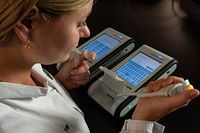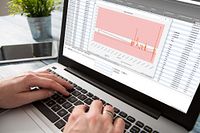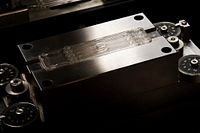Bacterial Endotoxins Test (BET)
Charles River uses LAL for all of our bacterial endotoxin test systems, reagents, and proprietary cartridge technology. As the most sensitive and robust assay available. We have transformed a qualitative bacterial endotoxin test gel-clot assay to a 15-minute quantitative bacterial endotoxin test assay available right on the production floor.
We have been at the forefront in the evolution of endotoxin testing, investing in the development of new technologies and innovative products to improve the quality of the endotoxin test and accelerate the development process. We've purposely built our portfolio of FDA-licensed products for rapid and traditional bacterial endotoxin testing to reduce retest rates and improve turnaround times so you can make prompt, confident decisions about the safety of your products.
Charles River's Bacterial Endotoxin Testing Portfolio
 Endosafe Cartridge Technology®: Endosafe® cartridge systems optimize and minimize the use of LAL in the detection of endotoxins while reducing time-consuming preparation steps, and a significant amount of raw materials and accessories needed by other BET test methods. Using the widely used kinetic chromogenic method, cartridges offer high sensitivity and rapid, quantitative results. Pre-loaded with all reagents needed to conduct an LAL tests, this also reduces the risk of human error in lengthy sample preparation steps and requires minimal training to operate.
Endosafe Cartridge Technology®: Endosafe® cartridge systems optimize and minimize the use of LAL in the detection of endotoxins while reducing time-consuming preparation steps, and a significant amount of raw materials and accessories needed by other BET test methods. Using the widely used kinetic chromogenic method, cartridges offer high sensitivity and rapid, quantitative results. Pre-loaded with all reagents needed to conduct an LAL tests, this also reduces the risk of human error in lengthy sample preparation steps and requires minimal training to operate.
 Endotoxin Testing Software: Our Endosafe® systems simplify the bacterial endotoxin test. Flexible methods and platforms meet the needs of the lab, regardless of sample volume or industry. With the ability to test raw materials, in-process samples, and final products, the simplistic Endosafe® cartridge technology increases technician efficiency and streamlines sample management by eliminating the variability associated with the daily reconstitution of the LAL reagent, preparation of endotoxin standards, and positive product controls. Every BET test system is backed by our skilled technical team who can provide training, maintenance, and support.
Endotoxin Testing Software: Our Endosafe® systems simplify the bacterial endotoxin test. Flexible methods and platforms meet the needs of the lab, regardless of sample volume or industry. With the ability to test raw materials, in-process samples, and final products, the simplistic Endosafe® cartridge technology increases technician efficiency and streamlines sample management by eliminating the variability associated with the daily reconstitution of the LAL reagent, preparation of endotoxin standards, and positive product controls. Every BET test system is backed by our skilled technical team who can provide training, maintenance, and support.
 LAL Test Reagents & Accessories: Our LAL reagents and LAL cartridges are licensed by the FDA for product release, and all of our accessory products are certified for the appropriate LAL bacterial endotoxin test requirements. These deliver extreme precision and reliability, minimizing invalid results and the need to retest.
LAL Test Reagents & Accessories: Our LAL reagents and LAL cartridges are licensed by the FDA for product release, and all of our accessory products are certified for the appropriate LAL bacterial endotoxin test requirements. These deliver extreme precision and reliability, minimizing invalid results and the need to retest.
Frequently Asked Questions (FAQs) for Bacterial Endotoxin Testing
-
What is endotoxin testing?
Endotoxin testing, or a bacterial endotoxin test (BET), such as LAL (limulus amebocyte lysate), is an in vitro assay used to detect bacterial endotoxins. The BET uses the lysate in blood cells from horseshoe crabs to detect bacterial endotoxins, thus warning quality control microbiologists of possible bacterial endotoxin contamination in their samples.
-
What is bacterial endotoxin?
A bacterial endotoxin is a type of pyrogen (a fever-causing agent) and is found in the cell wall of Gram-negative bacteria. If certain amounts of endotoxin are introduced into the bloodstream or spinal fluid via a parenteral drug or medical device, fever, septic shock, organ failure, or death can occur. Due to the possibility of serious illness or death, all injectable pharmaceutical products and implantable medical devices that come into contact with the bloodstream or spinal fluid are tested for endotoxins to ensure patient safety. These products and devices are tested for endotoxins with a bacterial endotoxin test (BET). The most reliable and accurate BET test utilizes LAL (limulus amebocyte lysate) to detect bacterial endotoxins in final product water from pharmaceutical water systems, and raw materials. Charles River offers a variety of bacterial endotoxin test FDA-licensed LAL reagents including the exclusive Endosafe® LAL cartridge technology, a rapid, simplified FDA licensed LAL test.
-
What products need to be tested for endotoxin?
All injectable pharmaceutical products and implantable medical devices, nuclear medicine and compounded parenterals need to be tested to ensure there is no presence of endotoxin, which can lead to a pyrogenic response (fever) and symptoms of septic shock. Endotoxins can be detected in these products and devices through bacterial endotoxin testing (BET). The most reliable and accurate bacterial endotoxin test uses LAL (limulus amebocyte lysate) to test for bacterial endotoxins. Charles River offers FDA-licensed LAL reagents for gel-clot, kinetic chromogenic, and kinetic turbidimetric BET test methods including the proprietary Endosafe LAL cartridge technology.
-
What is a rabbit pyrogen test?
The rabbit pyrogen test (RPT) is performed to check for the presence of pyrogens in products that could contain a Gram-negative or Gram-positive bacteria. Rabbits are used because their body temperature increases when they are injected with a pyrogenic product. From 1942 to 1983, the rabbit pyrogen test was the standard for pyrogen testing; however, it was labor-intensive, lengthy, and expensive. In 1983, the FDA and US Pharmacopeia adopted the bacterial endotoxin test utilizing Limulus amebocyte.
-
What is the difference between a Pyrogen Test and a Bacterial Endotoxin Test (BET)?
As an endotoxin is a type of pyrogen, both assays test for harmful Gram-negative bacteria that can produce life-threatening symptoms if introduced into the bloodstream or spinal fluid. The rabbit pyrogen test is an in vivo (performed inside of a living organism) test to detect pyrogens. If a rabbit is injected with a pyrogenic product, its body temperature will increase making it possible to determine the presence of pyrogens. However, the RPT is prone to errors and can result in the rabbit's death.
A bacterial endotoxin test (BET), such as LAL (limulus amebocyte lysate), is an in vitro assay used to detect bacterial endotoxins. The bacterial endotoxin test uses the lysate from blood cells from horseshoe crabs to detect bacterial endotoxins. As the BET is an in vitro (performed outside of a living organism; not a destructive assay) assay, the three principles of Replace, Reduce, and Refine was a primary consideration when developing the test.
-
Why is endotoxin testing important?
Endotoxin testing is important due to the risk of patient safety by not testing for endotoxins. If certain amounts of endotoxin are introduced into the bloodstream or spinal fluid via a parenteral drug or medical device, fever, septic shock, organ failure, or death can occur. It’s important to conduct testing in-process, as well as during final product testing, to ensure the safety of your product and patients. Learn more about endotoxin contamination control strategies in GMP Annex 1.
-
When is endotoxin testing required?
Endotoxin testing is required for any product that is being intravenously entered into the human body. All injectable pharmaceutical products and implantable medical devices must be tested for the presence of endotoxins. If endotoxins are present, it can lead to a pyrogenic response (fever) or symptoms of septic shock. It’s safe to reference your local regulatory requirements for endotoxin testing, such as USP, FDA and EP chapters.
-
What endotoxin test methods exist?
Several endotoxin test methods can be utilized, such as gel-clot, kinetic chromogenic, and kinetic turbidimetric bacterial endotoxin test, as well as the proprietary Endosafe LAL cartridge technology test method. The primary and most trusted method by both regulators, pharmaceutical manufacturers, and the general patient population is the LAL method.
-
What is the most widely used endotoxin test?
The most popular bacterial endotoxin test uses LAL (limulus amebocyte lysate) to test for bacterial endotoxins with over 70 million tests performed annually. Charles River offers FDA-licensed LAL reagents for gel-clot, kinetic chromogenic, and kinetic turbidimetric BET test methods including the proprietary Endosafe LAL cartridge technology.

